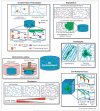Engineering synthetic hydrogel microenvironments to instruct stem cells
- PMID: 23545441
- PMCID: PMC3783596
- DOI: 10.1016/j.copbio.2013.03.009
Engineering synthetic hydrogel microenvironments to instruct stem cells
Abstract
Advances in our understanding and ability to manipulate stem cell behavior are helping to move stem cell-based therapies toward the clinic. However, much of our knowledge has been gained from standard 2-dimensional culture systems, which often misrepresent many of the signals that stem cells receive in their native 3-dimensional environments. Fortunately, the field of synthetic hydrogels is developing to better recapitulate many of these signals to guide stem cell behavior, both as in vitro models and as delivery vehicles for in vivo implantation. These include a multitude of structural and biochemical cues that can be presented on the cellular scale, such as degradation, adhesion, mechanical signals, topography, and the presentation of growth factors, often with precise spatiotemporal control.
Copyright © 2013 Elsevier Ltd. All rights reserved.
Figures

References
-
- Marklein RA, Burdick JA. Controlling stem cell fate with material design. Adv Mater. 2010;22:175–189. - PubMed
-
- Haycock JW. 3D cell culture: a review of current approaches and techniques. 3D Cell Culture: Methods and Protocols. Methods in Molecular Biology. 2011:1–15. - PubMed
-
- Tanaka H, Murphy CL, Murphy C, Kimura M, Kawai S, Polak JM. Chondrogenic differentiation of murine embryonic stem cells: effects of culture conditions and dexamethasone. J Cell Biochem. 2004;93:454–462. - PubMed
Publication types
MeSH terms
Substances
Grants and funding
LinkOut - more resources
Full Text Sources
Other Literature Sources
Medical

